A Grounded Theory Perspective of Agile UCD in Practice
VerifiedAdded on 2023/06/13
|12
|2631
|412
AI Summary
This paper examines the way incorporation of UCD (User-Centered Design) and agile approaches are practically done. For this research, it explores the applied grounded concept as an appropriate technique to regulate what is going on in actual practices. The developing subjects that were found by the study reveal a growing understanding of the significance of usability when developing software amongst agile group members.
Contribute Materials
Your contribution can guide someone’s learning journey. Share your
documents today.
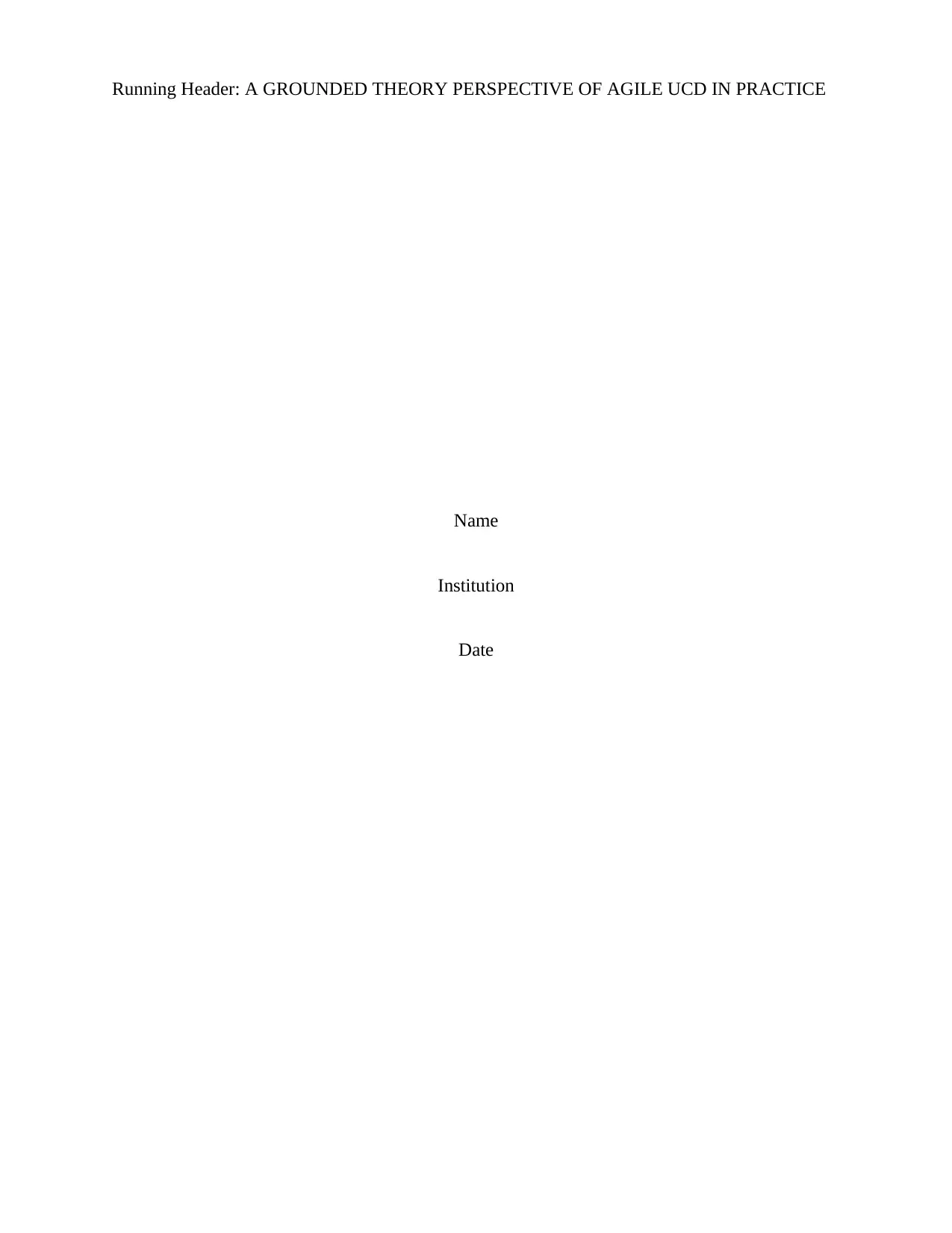
Running Header: A GROUNDED THEORY PERSPECTIVE OF AGILE UCD IN PRACTICE
Name
Institution
Date
Name
Institution
Date
Secure Best Marks with AI Grader
Need help grading? Try our AI Grader for instant feedback on your assignments.
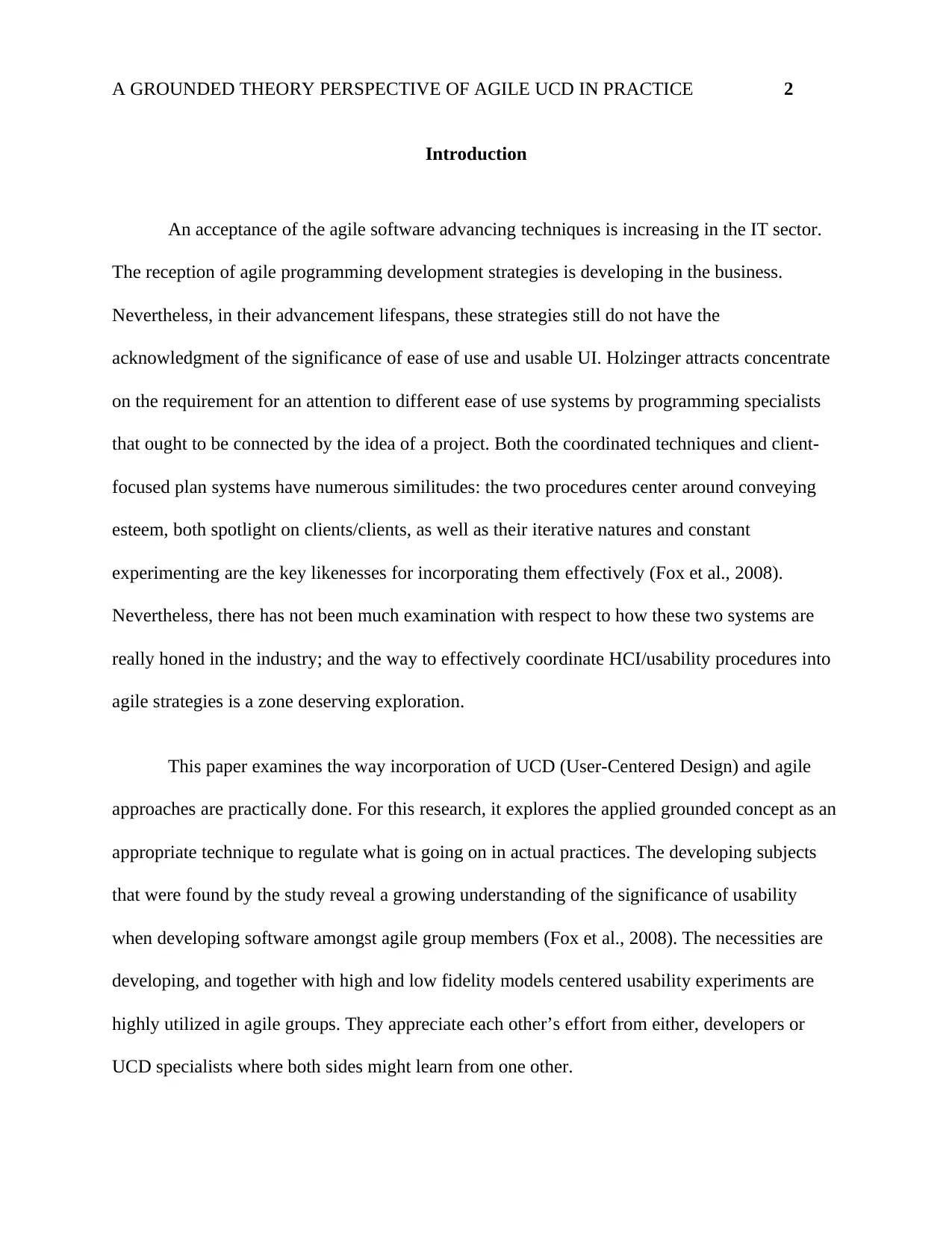
A GROUNDED THEORY PERSPECTIVE OF AGILE UCD IN PRACTICE 2
Introduction
An acceptance of the agile software advancing techniques is increasing in the IT sector.
The reception of agile programming development strategies is developing in the business.
Nevertheless, in their advancement lifespans, these strategies still do not have the
acknowledgment of the significance of ease of use and usable UI. Holzinger attracts concentrate
on the requirement for an attention to different ease of use systems by programming specialists
that ought to be connected by the idea of a project. Both the coordinated techniques and client-
focused plan systems have numerous similitudes: the two procedures center around conveying
esteem, both spotlight on clients/clients, as well as their iterative natures and constant
experimenting are the key likenesses for incorporating them effectively (Fox et al., 2008).
Nevertheless, there has not been much examination with respect to how these two systems are
really honed in the industry; and the way to effectively coordinate HCI/usability procedures into
agile strategies is a zone deserving exploration.
This paper examines the way incorporation of UCD (User-Centered Design) and agile
approaches are practically done. For this research, it explores the applied grounded concept as an
appropriate technique to regulate what is going on in actual practices. The developing subjects
that were found by the study reveal a growing understanding of the significance of usability
when developing software amongst agile group members (Fox et al., 2008). The necessities are
developing, and together with high and low fidelity models centered usability experiments are
highly utilized in agile groups. They appreciate each other’s effort from either, developers or
UCD specialists where both sides might learn from one other.
Introduction
An acceptance of the agile software advancing techniques is increasing in the IT sector.
The reception of agile programming development strategies is developing in the business.
Nevertheless, in their advancement lifespans, these strategies still do not have the
acknowledgment of the significance of ease of use and usable UI. Holzinger attracts concentrate
on the requirement for an attention to different ease of use systems by programming specialists
that ought to be connected by the idea of a project. Both the coordinated techniques and client-
focused plan systems have numerous similitudes: the two procedures center around conveying
esteem, both spotlight on clients/clients, as well as their iterative natures and constant
experimenting are the key likenesses for incorporating them effectively (Fox et al., 2008).
Nevertheless, there has not been much examination with respect to how these two systems are
really honed in the industry; and the way to effectively coordinate HCI/usability procedures into
agile strategies is a zone deserving exploration.
This paper examines the way incorporation of UCD (User-Centered Design) and agile
approaches are practically done. For this research, it explores the applied grounded concept as an
appropriate technique to regulate what is going on in actual practices. The developing subjects
that were found by the study reveal a growing understanding of the significance of usability
when developing software amongst agile group members (Fox et al., 2008). The necessities are
developing, and together with high and low fidelity models centered usability experiments are
highly utilized in agile groups. They appreciate each other’s effort from either, developers or
UCD specialists where both sides might learn from one other.

A GROUNDED THEORY PERSPECTIVE OF AGILE UCD IN PRACTICE 3
Agile software development
Agile Growth is another term representing several iterative as well as incremental
software growth practices (Chamberlain et al., 2006). The most common agile practices include
Lean Development, FDD (Feature-Driven Development), Crystal, Scrum, XP (Extreme
Programming) and DSDM (Dynamic Systems Development Method).
Even though every agile practice is distinctive in its particular tactic, they all have the
same core values and a common vision. They all incorporate repetition as well as the continuous
response that it offers to successively improve and supply the software systems (Rosser et al.,
2014). They all include continuous planning, continuous integration, continuous testing, and
other practices of continuous development of both software and the project. All are lightweight,
particularly when compared to old waterfall-style procedures, and inherently adjustable. The
most important thing about agile systems is the focus they all have on allowing people to work
and making decisions together effectively and quickly.
Background of Agile software development
Various individual practices and principles that are encouraged by agile growth have
been in place for many years. Instead of implementing these paramount practices fragmentary,
agile practices have "packaged" management, various customers, and some instances,
engineering approaches, and values together to assist guide groups through the procedure of
rapidly organization and producing working, verified software (Chamberlain et al., 2006). All the
Agile software development
Agile Growth is another term representing several iterative as well as incremental
software growth practices (Chamberlain et al., 2006). The most common agile practices include
Lean Development, FDD (Feature-Driven Development), Crystal, Scrum, XP (Extreme
Programming) and DSDM (Dynamic Systems Development Method).
Even though every agile practice is distinctive in its particular tactic, they all have the
same core values and a common vision. They all incorporate repetition as well as the continuous
response that it offers to successively improve and supply the software systems (Rosser et al.,
2014). They all include continuous planning, continuous integration, continuous testing, and
other practices of continuous development of both software and the project. All are lightweight,
particularly when compared to old waterfall-style procedures, and inherently adjustable. The
most important thing about agile systems is the focus they all have on allowing people to work
and making decisions together effectively and quickly.
Background of Agile software development
Various individual practices and principles that are encouraged by agile growth have
been in place for many years. Instead of implementing these paramount practices fragmentary,
agile practices have "packaged" management, various customers, and some instances,
engineering approaches, and values together to assist guide groups through the procedure of
rapidly organization and producing working, verified software (Chamberlain et al., 2006). All the
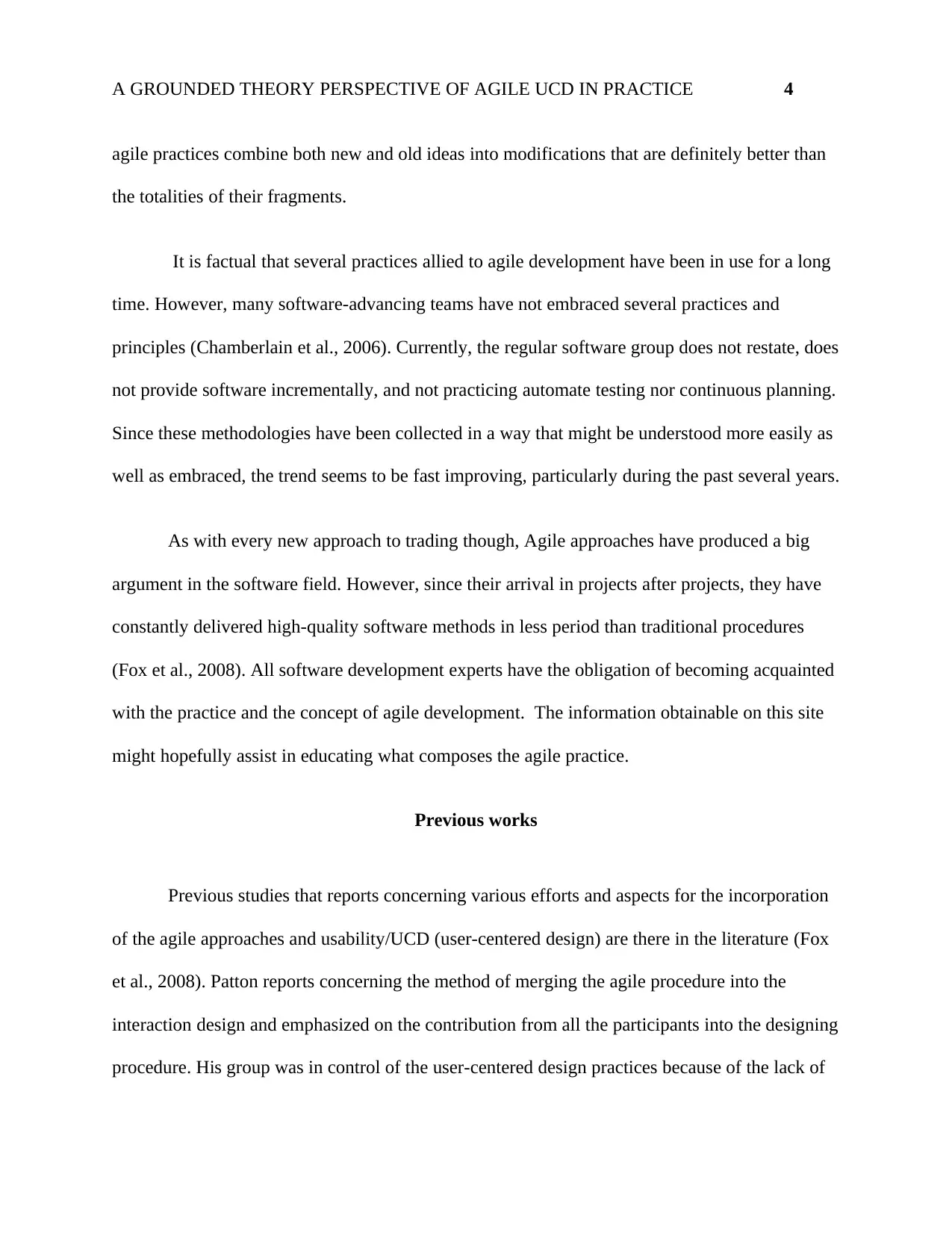
A GROUNDED THEORY PERSPECTIVE OF AGILE UCD IN PRACTICE 4
agile practices combine both new and old ideas into modifications that are definitely better than
the totalities of their fragments.
It is factual that several practices allied to agile development have been in use for a long
time. However, many software-advancing teams have not embraced several practices and
principles (Chamberlain et al., 2006). Currently, the regular software group does not restate, does
not provide software incrementally, and not practicing automate testing nor continuous planning.
Since these methodologies have been collected in a way that might be understood more easily as
well as embraced, the trend seems to be fast improving, particularly during the past several years.
As with every new approach to trading though, Agile approaches have produced a big
argument in the software field. However, since their arrival in projects after projects, they have
constantly delivered high-quality software methods in less period than traditional procedures
(Fox et al., 2008). All software development experts have the obligation of becoming acquainted
with the practice and the concept of agile development. The information obtainable on this site
might hopefully assist in educating what composes the agile practice.
Previous works
Previous studies that reports concerning various efforts and aspects for the incorporation
of the agile approaches and usability/UCD (user-centered design) are there in the literature (Fox
et al., 2008). Patton reports concerning the method of merging the agile procedure into the
interaction design and emphasized on the contribution from all the participants into the designing
procedure. His group was in control of the user-centered design practices because of the lack of
agile practices combine both new and old ideas into modifications that are definitely better than
the totalities of their fragments.
It is factual that several practices allied to agile development have been in use for a long
time. However, many software-advancing teams have not embraced several practices and
principles (Chamberlain et al., 2006). Currently, the regular software group does not restate, does
not provide software incrementally, and not practicing automate testing nor continuous planning.
Since these methodologies have been collected in a way that might be understood more easily as
well as embraced, the trend seems to be fast improving, particularly during the past several years.
As with every new approach to trading though, Agile approaches have produced a big
argument in the software field. However, since their arrival in projects after projects, they have
constantly delivered high-quality software methods in less period than traditional procedures
(Fox et al., 2008). All software development experts have the obligation of becoming acquainted
with the practice and the concept of agile development. The information obtainable on this site
might hopefully assist in educating what composes the agile practice.
Previous works
Previous studies that reports concerning various efforts and aspects for the incorporation
of the agile approaches and usability/UCD (user-centered design) are there in the literature (Fox
et al., 2008). Patton reports concerning the method of merging the agile procedure into the
interaction design and emphasized on the contribution from all the participants into the designing
procedure. His group was in control of the user-centered design practices because of the lack of
Secure Best Marks with AI Grader
Need help grading? Try our AI Grader for instant feedback on your assignments.
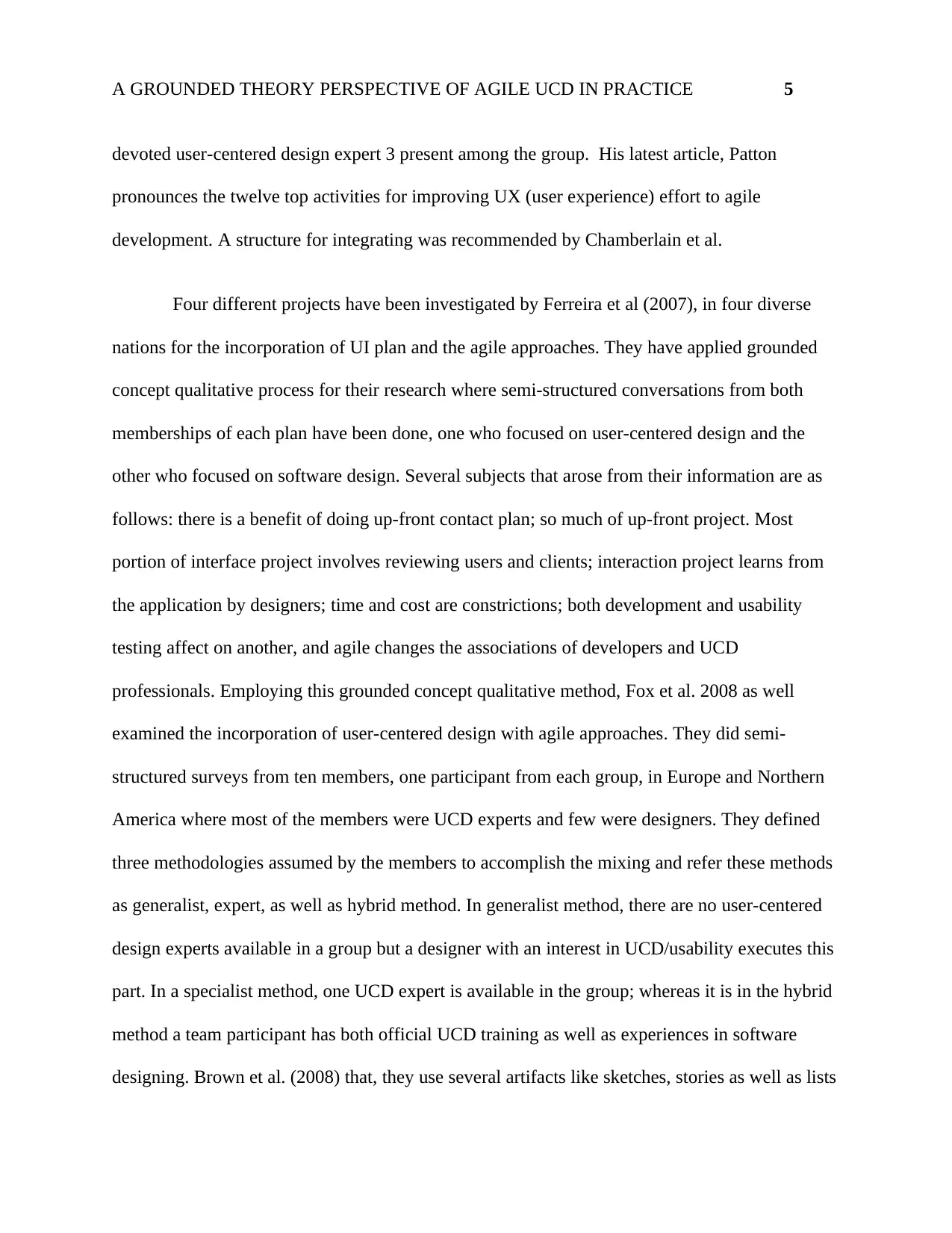
A GROUNDED THEORY PERSPECTIVE OF AGILE UCD IN PRACTICE 5
devoted user-centered design expert 3 present among the group. His latest article, Patton
pronounces the twelve top activities for improving UX (user experience) effort to agile
development. A structure for integrating was recommended by Chamberlain et al.
Four different projects have been investigated by Ferreira et al (2007), in four diverse
nations for the incorporation of UI plan and the agile approaches. They have applied grounded
concept qualitative process for their research where semi-structured conversations from both
memberships of each plan have been done, one who focused on user-centered design and the
other who focused on software design. Several subjects that arose from their information are as
follows: there is a benefit of doing up-front contact plan; so much of up-front project. Most
portion of interface project involves reviewing users and clients; interaction project learns from
the application by designers; time and cost are constrictions; both development and usability
testing affect on another, and agile changes the associations of developers and UCD
professionals. Employing this grounded concept qualitative method, Fox et al. 2008 as well
examined the incorporation of user-centered design with agile approaches. They did semi-
structured surveys from ten members, one participant from each group, in Europe and Northern
America where most of the members were UCD experts and few were designers. They defined
three methodologies assumed by the members to accomplish the mixing and refer these methods
as generalist, expert, as well as hybrid method. In generalist method, there are no user-centered
design experts available in a group but a designer with an interest in UCD/usability executes this
part. In a specialist method, one UCD expert is available in the group; whereas it is in the hybrid
method a team participant has both official UCD training as well as experiences in software
designing. Brown et al. (2008) that, they use several artifacts like sketches, stories as well as lists
devoted user-centered design expert 3 present among the group. His latest article, Patton
pronounces the twelve top activities for improving UX (user experience) effort to agile
development. A structure for integrating was recommended by Chamberlain et al.
Four different projects have been investigated by Ferreira et al (2007), in four diverse
nations for the incorporation of UI plan and the agile approaches. They have applied grounded
concept qualitative process for their research where semi-structured conversations from both
memberships of each plan have been done, one who focused on user-centered design and the
other who focused on software design. Several subjects that arose from their information are as
follows: there is a benefit of doing up-front contact plan; so much of up-front project. Most
portion of interface project involves reviewing users and clients; interaction project learns from
the application by designers; time and cost are constrictions; both development and usability
testing affect on another, and agile changes the associations of developers and UCD
professionals. Employing this grounded concept qualitative method, Fox et al. 2008 as well
examined the incorporation of user-centered design with agile approaches. They did semi-
structured surveys from ten members, one participant from each group, in Europe and Northern
America where most of the members were UCD experts and few were designers. They defined
three methodologies assumed by the members to accomplish the mixing and refer these methods
as generalist, expert, as well as hybrid method. In generalist method, there are no user-centered
design experts available in a group but a designer with an interest in UCD/usability executes this
part. In a specialist method, one UCD expert is available in the group; whereas it is in the hybrid
method a team participant has both official UCD training as well as experiences in software
designing. Brown et al. (2008) that, they use several artifacts like sketches, stories as well as lists

A GROUNDED THEORY PERSPECTIVE OF AGILE UCD IN PRACTICE 6
of UCD experts and designer in the agile procedure report it. Ungar states the benefits of
presenting a Project Studio, a cooperative, a concerted workstation, into agile UCD procedure.
The design workshop is a fast procedure that lets designers, stakeholders, and developers to
explore and collaborate design choices. Developers grow their expertise by exchanging ideas
with their co-workers and freely deliberating the weaknesses and strengths of their effort. The
designs are strengthened and enriched from the feedbacks.
Apart from the content of few kinds of research, several studies are subjective; although
providing vital information that shows the way UCD is assimilated with agile approaches at
different levels as well as at different levels of determinations (Cantone, & Marchesi, 2014).
Studying the different phases of the assimilation of usability/UCD and agile methods is the
section worth exploration to develop quality and usable software products. This study aimed at
increasing this understanding base to find new subjects, and supportive as well as approving the
prevailing practical proof by applying grounded concept qualitative method.
User-centered design and Agile
Delivering huge improvement in reliable software has been enabled by agile software
development movement reducing the risk of development and increasing return on investment.
Nonetheless, in a universe of iPhones and Google applications, this may never again be
sufficient. Individuals are starting to expect more from programming. They anticipate that it will
work, instinctively and bother free, as though it were developed only for them. As clients turn
out to be more computer shrewd, they have a better comprehension of how they anticipate that
software will function. As a rule, clients know what they need to accomplish. Any product that
of UCD experts and designer in the agile procedure report it. Ungar states the benefits of
presenting a Project Studio, a cooperative, a concerted workstation, into agile UCD procedure.
The design workshop is a fast procedure that lets designers, stakeholders, and developers to
explore and collaborate design choices. Developers grow their expertise by exchanging ideas
with their co-workers and freely deliberating the weaknesses and strengths of their effort. The
designs are strengthened and enriched from the feedbacks.
Apart from the content of few kinds of research, several studies are subjective; although
providing vital information that shows the way UCD is assimilated with agile approaches at
different levels as well as at different levels of determinations (Cantone, & Marchesi, 2014).
Studying the different phases of the assimilation of usability/UCD and agile methods is the
section worth exploration to develop quality and usable software products. This study aimed at
increasing this understanding base to find new subjects, and supportive as well as approving the
prevailing practical proof by applying grounded concept qualitative method.
User-centered design and Agile
Delivering huge improvement in reliable software has been enabled by agile software
development movement reducing the risk of development and increasing return on investment.
Nonetheless, in a universe of iPhones and Google applications, this may never again be
sufficient. Individuals are starting to expect more from programming. They anticipate that it will
work, instinctively and bother free, as though it were developed only for them. As clients turn
out to be more computer shrewd, they have a better comprehension of how they anticipate that
software will function. As a rule, clients know what they need to accomplish. Any product that
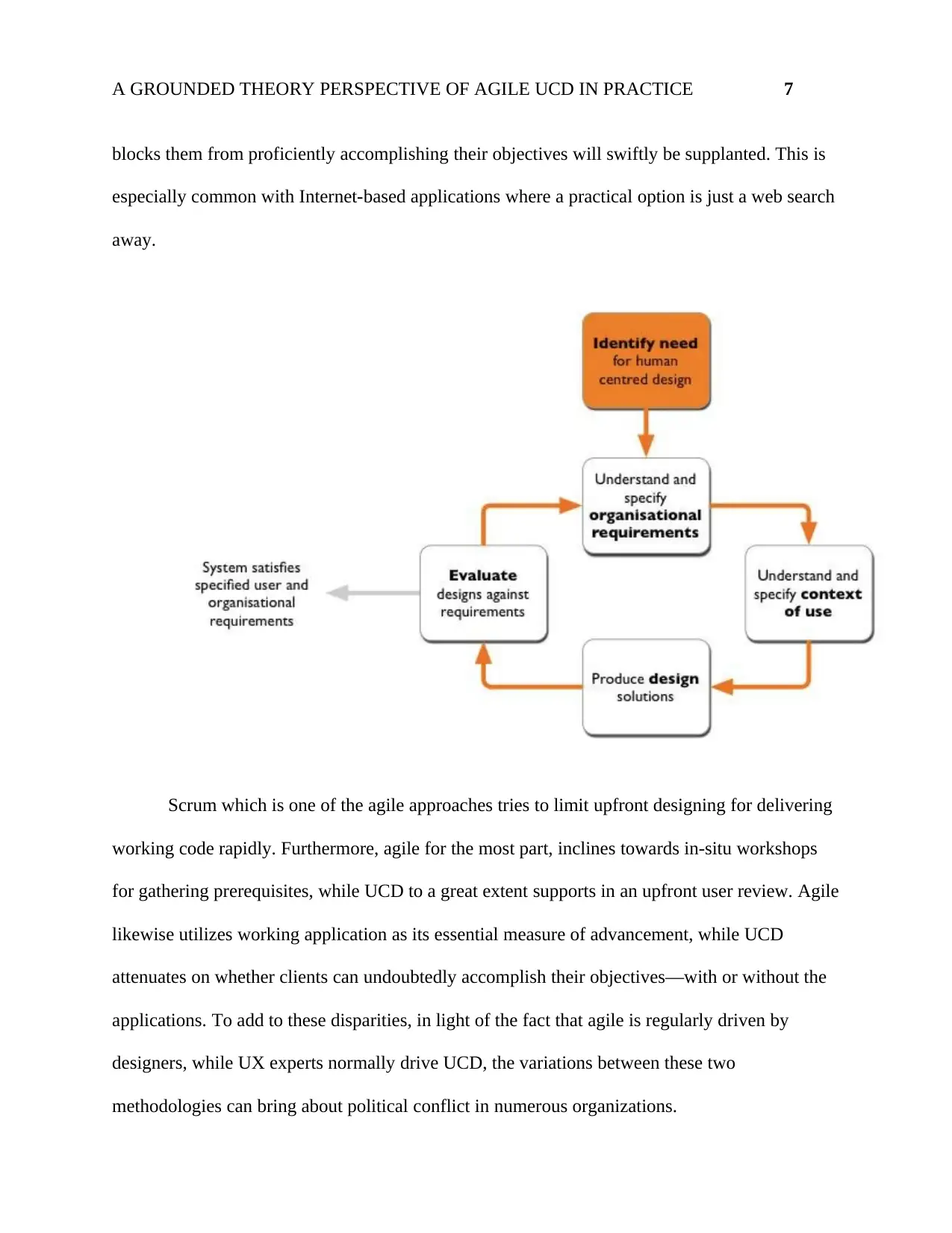
A GROUNDED THEORY PERSPECTIVE OF AGILE UCD IN PRACTICE 7
blocks them from proficiently accomplishing their objectives will swiftly be supplanted. This is
especially common with Internet-based applications where a practical option is just a web search
away.
Scrum which is one of the agile approaches tries to limit upfront designing for delivering
working code rapidly. Furthermore, agile for the most part, inclines towards in-situ workshops
for gathering prerequisites, while UCD to a great extent supports in an upfront user review. Agile
likewise utilizes working application as its essential measure of advancement, while UCD
attenuates on whether clients can undoubtedly accomplish their objectives—with or without the
applications. To add to these disparities, in light of the fact that agile is regularly driven by
designers, while UX experts normally drive UCD, the variations between these two
methodologies can bring about political conflict in numerous organizations.
blocks them from proficiently accomplishing their objectives will swiftly be supplanted. This is
especially common with Internet-based applications where a practical option is just a web search
away.
Scrum which is one of the agile approaches tries to limit upfront designing for delivering
working code rapidly. Furthermore, agile for the most part, inclines towards in-situ workshops
for gathering prerequisites, while UCD to a great extent supports in an upfront user review. Agile
likewise utilizes working application as its essential measure of advancement, while UCD
attenuates on whether clients can undoubtedly accomplish their objectives—with or without the
applications. To add to these disparities, in light of the fact that agile is regularly driven by
designers, while UX experts normally drive UCD, the variations between these two
methodologies can bring about political conflict in numerous organizations.
Paraphrase This Document
Need a fresh take? Get an instant paraphrase of this document with our AI Paraphraser
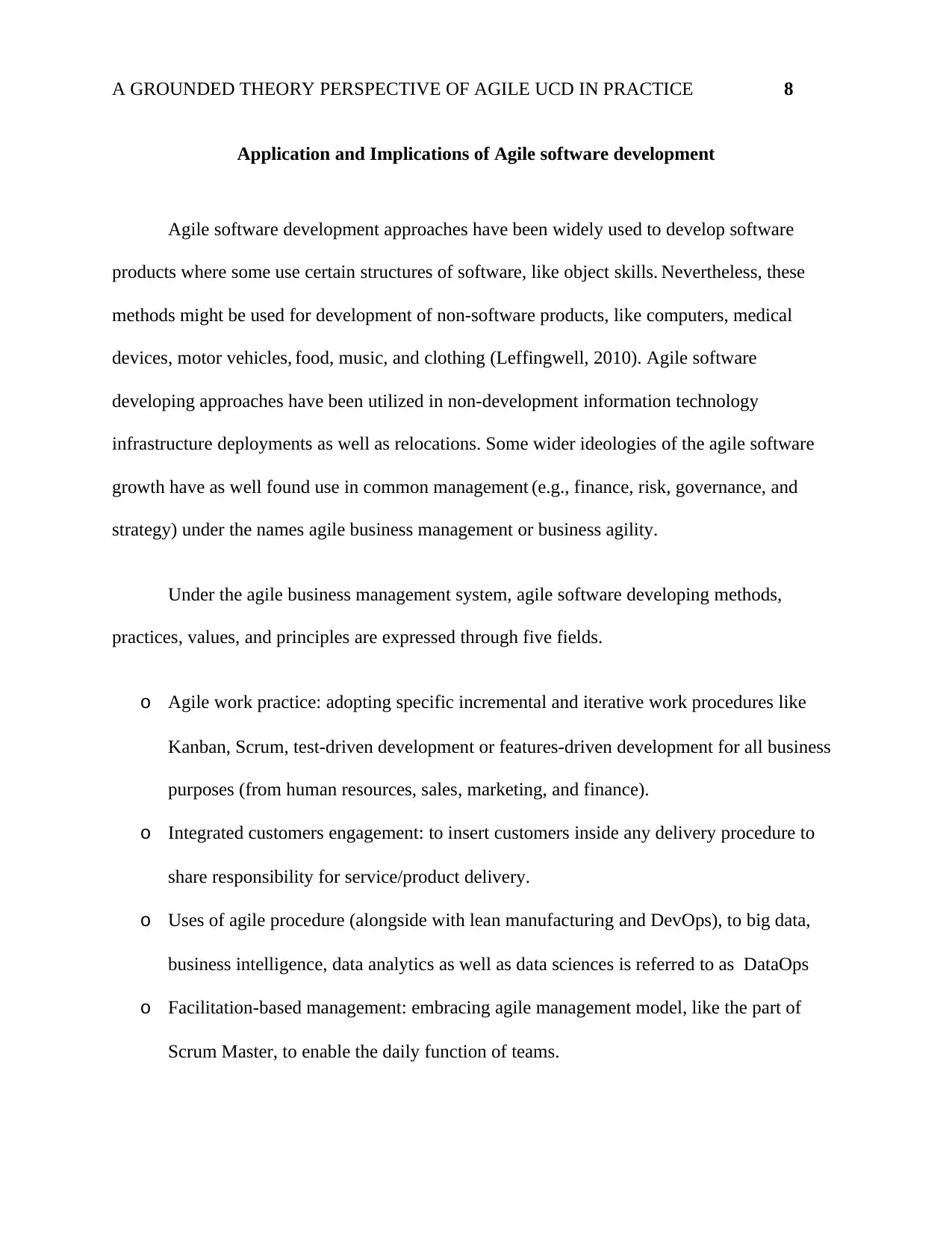
A GROUNDED THEORY PERSPECTIVE OF AGILE UCD IN PRACTICE 8
Application and Implications of Agile software development
Agile software development approaches have been widely used to develop software
products where some use certain structures of software, like object skills. Nevertheless, these
methods might be used for development of non-software products, like computers, medical
devices, motor vehicles, food, music, and clothing (Leffingwell, 2010). Agile software
developing approaches have been utilized in non-development information technology
infrastructure deployments as well as relocations. Some wider ideologies of the agile software
growth have as well found use in common management (e.g., finance, risk, governance, and
strategy) under the names agile business management or business agility.
Under the agile business management system, agile software developing methods,
practices, values, and principles are expressed through five fields.
o Agile work practice: adopting specific incremental and iterative work procedures like
Kanban, Scrum, test-driven development or features-driven development for all business
purposes (from human resources, sales, marketing, and finance).
o Integrated customers engagement: to insert customers inside any delivery procedure to
share responsibility for service/product delivery.
o Uses of agile procedure (alongside with lean manufacturing and DevOps), to big data,
business intelligence, data analytics as well as data sciences is referred to as DataOps
o Facilitation-based management: embracing agile management model, like the part of
Scrum Master, to enable the daily function of teams.
Application and Implications of Agile software development
Agile software development approaches have been widely used to develop software
products where some use certain structures of software, like object skills. Nevertheless, these
methods might be used for development of non-software products, like computers, medical
devices, motor vehicles, food, music, and clothing (Leffingwell, 2010). Agile software
developing approaches have been utilized in non-development information technology
infrastructure deployments as well as relocations. Some wider ideologies of the agile software
growth have as well found use in common management (e.g., finance, risk, governance, and
strategy) under the names agile business management or business agility.
Under the agile business management system, agile software developing methods,
practices, values, and principles are expressed through five fields.
o Agile work practice: adopting specific incremental and iterative work procedures like
Kanban, Scrum, test-driven development or features-driven development for all business
purposes (from human resources, sales, marketing, and finance).
o Integrated customers engagement: to insert customers inside any delivery procedure to
share responsibility for service/product delivery.
o Uses of agile procedure (alongside with lean manufacturing and DevOps), to big data,
business intelligence, data analytics as well as data sciences is referred to as DataOps
o Facilitation-based management: embracing agile management model, like the part of
Scrum Master, to enable the daily function of teams.

A GROUNDED THEORY PERSPECTIVE OF AGILE UCD IN PRACTICE 9
Agile software development models can be utilized in other fields of life like bringing up
children. Its achievement in raising children might be seen on some simple management
principles; awareness, adaptation, and communication (Chamberlain et al., 2006). In a TED
Talks, Bruce Feiler stated how he used basic agile models to raise children and to manage the
household.
Conclusion
In conclusion, the paper examined how a combination of the agile approaches and UCD
(user-centered design) is practically carried out applying a grounded concept. The developing
subjects that the research found illustrate that in agile method team participants there is growing
understanding for the significance of UCD/usability in the application growth; whereas agile
approaches also offer benefits of UCD/usability because of its assimilation. The members also
stated that incorporating UCD/usability into the agile procedure has improved the usability and
the qualities of the products and increase the gratification of the consumers. Some as well stated
that this assimilation has increased importance to their group in the procedure.
Some open designs are done to appreciate users, their objectives, as well as the plan’s
objective. The necessities are developing. The usability variations are handled in the same
reiteration series or in the subsequent iteration cycle reliant upon their size. Both high and low
fidelity models grounded usability experiments are vastly utilized in agile groups. The
appreciation is there, toward each other's efforts of both developers and UCD professionals
where each side learns from the other. Virtually all the outcomes resemble with the prevailing
studies available in the literature. The previously acknowledged subjects by Fox et al. (2008)
Agile software development models can be utilized in other fields of life like bringing up
children. Its achievement in raising children might be seen on some simple management
principles; awareness, adaptation, and communication (Chamberlain et al., 2006). In a TED
Talks, Bruce Feiler stated how he used basic agile models to raise children and to manage the
household.
Conclusion
In conclusion, the paper examined how a combination of the agile approaches and UCD
(user-centered design) is practically carried out applying a grounded concept. The developing
subjects that the research found illustrate that in agile method team participants there is growing
understanding for the significance of UCD/usability in the application growth; whereas agile
approaches also offer benefits of UCD/usability because of its assimilation. The members also
stated that incorporating UCD/usability into the agile procedure has improved the usability and
the qualities of the products and increase the gratification of the consumers. Some as well stated
that this assimilation has increased importance to their group in the procedure.
Some open designs are done to appreciate users, their objectives, as well as the plan’s
objective. The necessities are developing. The usability variations are handled in the same
reiteration series or in the subsequent iteration cycle reliant upon their size. Both high and low
fidelity models grounded usability experiments are vastly utilized in agile groups. The
appreciation is there, toward each other's efforts of both developers and UCD professionals
where each side learns from the other. Virtually all the outcomes resemble with the prevailing
studies available in the literature. The previously acknowledged subjects by Fox et al. (2008)
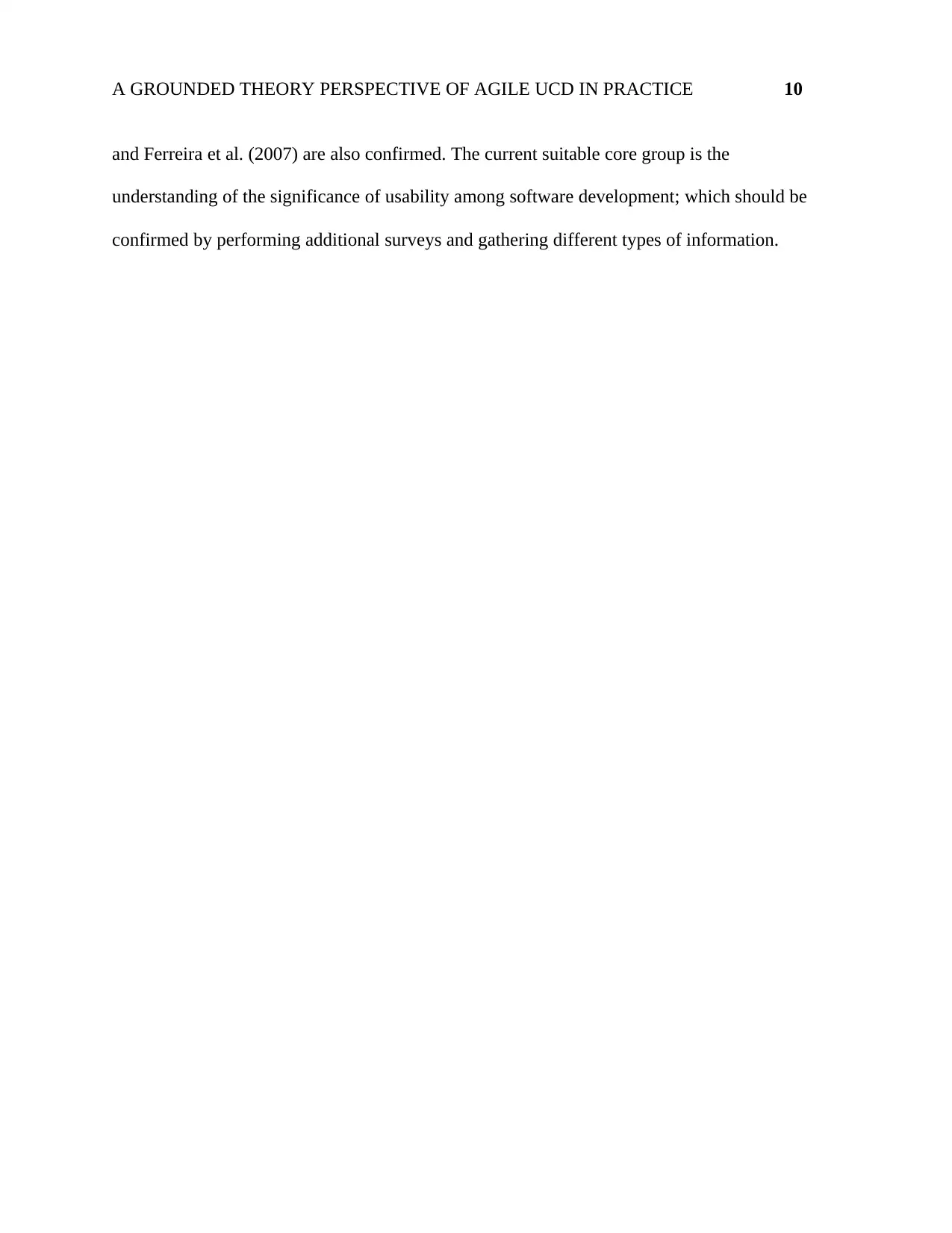
A GROUNDED THEORY PERSPECTIVE OF AGILE UCD IN PRACTICE 10
and Ferreira et al. (2007) are also confirmed. The current suitable core group is the
understanding of the significance of usability among software development; which should be
confirmed by performing additional surveys and gathering different types of information.
and Ferreira et al. (2007) are also confirmed. The current suitable core group is the
understanding of the significance of usability among software development; which should be
confirmed by performing additional surveys and gathering different types of information.
Secure Best Marks with AI Grader
Need help grading? Try our AI Grader for instant feedback on your assignments.

A GROUNDED THEORY PERSPECTIVE OF AGILE UCD IN PRACTICE 11
Bibliography
Cantone, G., & Marchesi, M. (2014, May). Agile processes in software engineering and extreme
programming. In Proceedings of the 15th international conference, XP.
Chamberlain, S., Sharp, H., & Maiden, N. (2006, June). Towards a framework for integrating
agile development and user-centered design. In International Conference on Extreme
Programming and Agile Processes in Software Engineering(pp. 143-153). Springer, Berlin,
Heidelberg.
Ferreira, J., Noble, J., & Biddle, R. (2007, June). Up-front interaction design in agile
development. In International Conference on Extreme Programming and Agile Processes in
Software Engineering (pp. 9-16). Springer, Berlin, Heidelberg.
Fox, D., Sillito, J., & Maurer, F. (2008, August). Agile methods and user-centered design: How
these two methodologies are being successfully integrated into the industry. In Agile, 2008.
AGILE'08. Conference (pp. 63-72). IEEE.
Leffingwell, D. (2010). Agile software requirements: lean requirements practices for teams,
programs, and the enterprise. Addison-Wesley Professional.
Rosser, L., Marbach, P., Lempia, D., & Osvalds, G. (2014). Systems Engineering for Software
Intensive Projects Using Agile Methods. International Council on Systems Engineering IS2014,
Las Vegas, US-NV, 30.
Bibliography
Cantone, G., & Marchesi, M. (2014, May). Agile processes in software engineering and extreme
programming. In Proceedings of the 15th international conference, XP.
Chamberlain, S., Sharp, H., & Maiden, N. (2006, June). Towards a framework for integrating
agile development and user-centered design. In International Conference on Extreme
Programming and Agile Processes in Software Engineering(pp. 143-153). Springer, Berlin,
Heidelberg.
Ferreira, J., Noble, J., & Biddle, R. (2007, June). Up-front interaction design in agile
development. In International Conference on Extreme Programming and Agile Processes in
Software Engineering (pp. 9-16). Springer, Berlin, Heidelberg.
Fox, D., Sillito, J., & Maurer, F. (2008, August). Agile methods and user-centered design: How
these two methodologies are being successfully integrated into the industry. In Agile, 2008.
AGILE'08. Conference (pp. 63-72). IEEE.
Leffingwell, D. (2010). Agile software requirements: lean requirements practices for teams,
programs, and the enterprise. Addison-Wesley Professional.
Rosser, L., Marbach, P., Lempia, D., & Osvalds, G. (2014). Systems Engineering for Software
Intensive Projects Using Agile Methods. International Council on Systems Engineering IS2014,
Las Vegas, US-NV, 30.
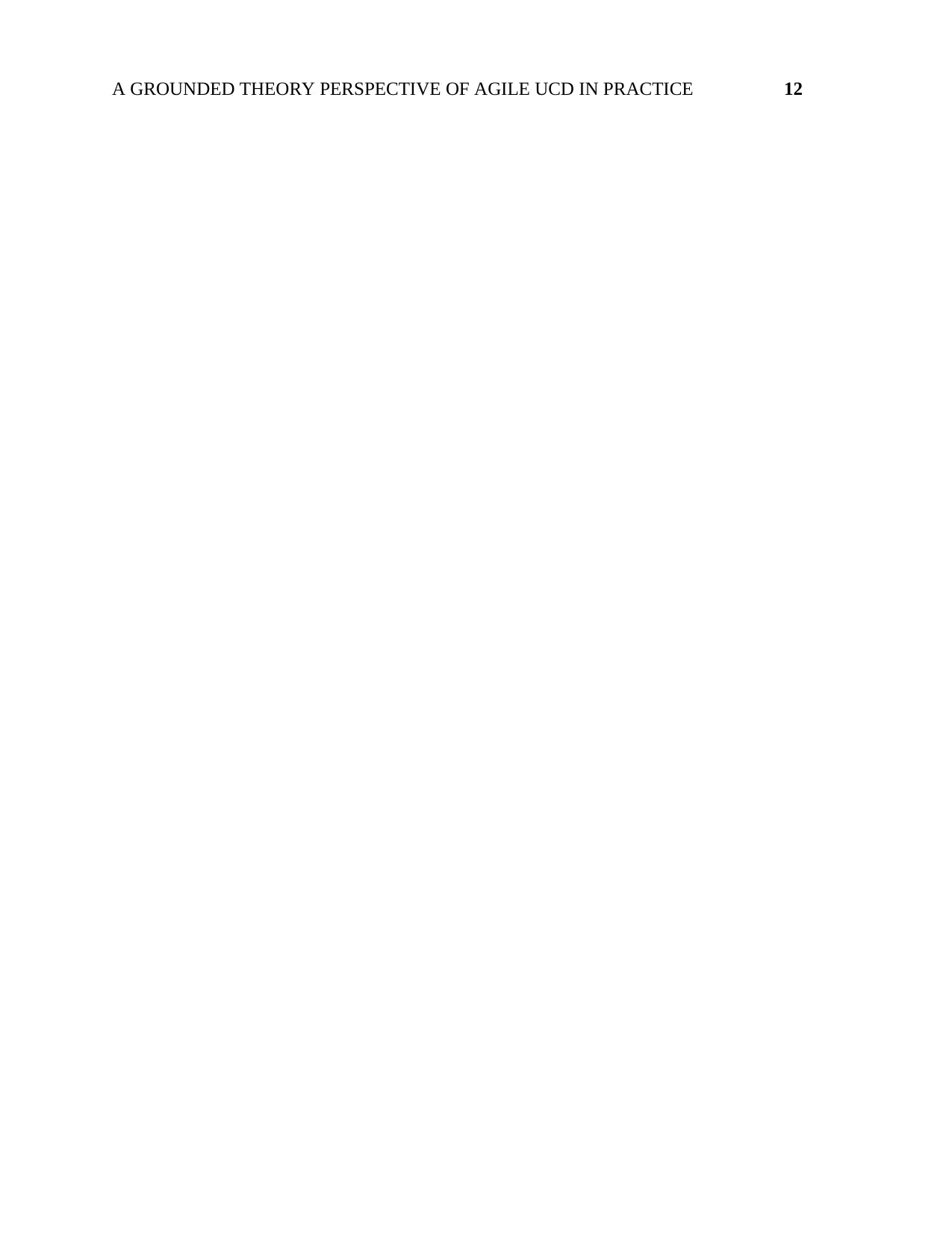
A GROUNDED THEORY PERSPECTIVE OF AGILE UCD IN PRACTICE 12
1 out of 12
Your All-in-One AI-Powered Toolkit for Academic Success.
+13062052269
info@desklib.com
Available 24*7 on WhatsApp / Email
![[object Object]](/_next/static/media/star-bottom.7253800d.svg)
Unlock your academic potential
© 2024 | Zucol Services PVT LTD | All rights reserved.


